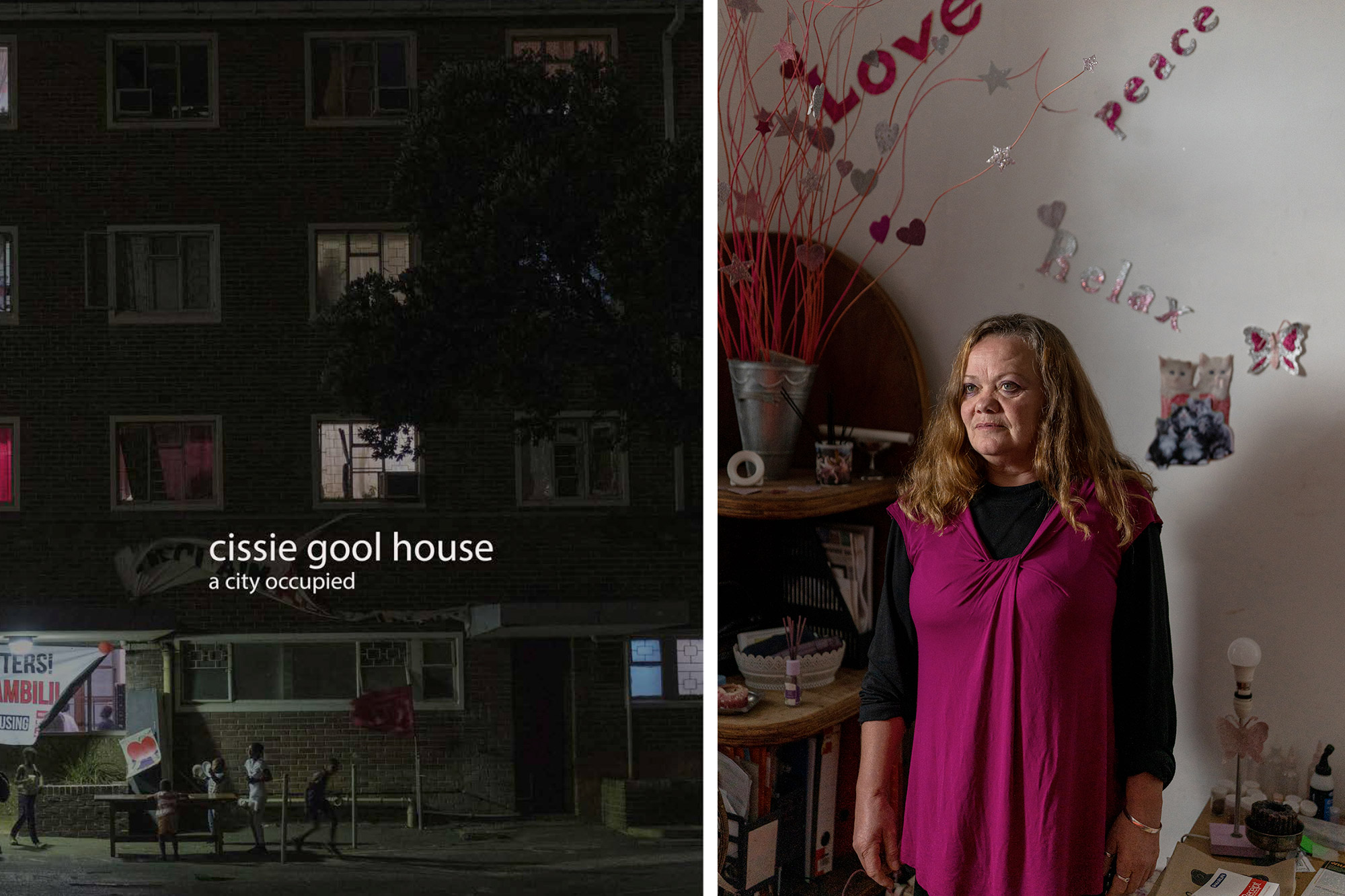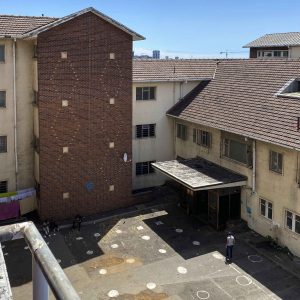Residents, not occupiers, live at Cissie Gool House
A zine that depicts those living in what used to be an abandoned hospital in Woodstock reframes and humanises the same people the government has labelled criminals.
Author:
2 March 2022

The mainstream story of those living in Cissie Gool House is that they are criminals, illegal occupiers and queue-jumpers unwilling to wait for state-subsidised housing. But as resident Miles Sampson says, “I know people on the waiting list for 30 years, 40 years. We’re going to die still waiting for a house.”
Cissie Gool House was an old, empty Woodstock hospital in central Cape Town that residents transformed into housing, as gentrification in the area forced hundreds of them from their homes. The initial occupation started with the non-profit organisation Reclaim the City as it fought, and continues to fight, for affordable housing in the inner city, and for people who have been evicted.
Related article:
Recently a team came together to produce Cissie Gool House: A City Occupied, a zine that includes voices from residents. “There are actual people living here,” says photojournalist Barry Christianson. “This is who they are.”
The zine, which Suraya Scheba and Tommaso Cosentino researched and Christianson produced, designed and photographed, focuses on the residents’ stories to produce a counter-narrative to the prevailing one.
In their own words, 14 residents let readers into their world as they share stories of displacement, hope, resistance and home. They reflect on what led them to Cissie Gool House and what the space represents in Cape Town. One of the earliest residents, Jennifer Williams, says: “We don’t say we are occupiers. This is our home.” Sheena Smith mirrors this: “I would like to be called resident, not occupier.”
What is Cissie Gool House?
What began as a project and tactic to hold the city accountable for providing housing has become a long-term home, giving residents access to the city since 2017. Cissie Gool House currently houses 338 families in Woodstock, with about 1 200 people living there.
Resident Amanda Gericke describes the abandoned hospital as being filthy and infested with rats and human faeces before they “cleaned this place up, room by room”.
Cissie Gool House is now a place of structure with leadership, hall monitors, task teams, meetings, internal conflict resolution, gender-based violence workshops, refuse collection areas and a working kitchen with a garden that helps feed residents. School pupils and matriculants receive therapy on occasion, and resources such as worksheets, papers and old crayons are gathered for the children. It is a place where the sick are nursed; where the youth and their talents are nurtured; where, if something breaks, it is fixed; and importantly, where the residents learn their rights when it comes to eviction.
From plumbing and painting to electrical maintenance, the residents all contribute to making and taking care of their space, according to their skill sets. It’s a needs-based space, transformed from disrepair through internal organisation.
“They want to get rid of us here. Maybe they must come see how we are living,” says Ismael Sheik.
The nature of Cissie Gool House contrasts strongly with the way member of the mayoral committee for human settlements Malusi Booi portrays Reclaim the City, calling its actions unlawful and destructive to property. Booi has said that plans to develop social housing at Cissie Gool House could be derailed if the residents refuse to leave and discouraged the illegal occupation of land. But who controls the land?
A history of resistance
There’s a disturbing parallel between the forced removals of the 1960s owing to the Group Areas Act and the mass evictions happening in Cape Town today. Many Capetonians who lived through apartheid are either being displaced again or watching their children be displaced. This intergenerational trauma six decades later in the gentrified spatial apartheid of Cape Town is unsettling.
“We had evictions in District Six and those are the most infamous of the forced removals,” says Christianson. “You’ve got a whole bunch of people who were evicted from District Six and moved to Gympie Street or the surrounds [in Woodstock and Salt River]. And so these people survived apartheid, but they can’t survive democracy. In Cissie Gool House, there’s a bunch of people who have experienced [displacement] twice.”
Spatial apartheid and forced removals remain a reality in the postapartheid state, and Cissie Gool House is just one example of the continuing Cape Town housing struggle. Displacing people not only takes away their homes, but also denies them proximity to the city and its opportunities. Many of those evicted from Woodstock have been pushed to far-out areas such as Wolwerivier, where access to work is more difficult.
Related article:
Resident Faghmeeda Ling says: “The city wanted to put us out there in Wolwerivier, like some piece of equipment, not a human being! To them, we were a problem to throw out – out of sight, out of mind. Families living in Gympie Street were offered money and were thrown in Blikkiesdorp.”
Keeping certain people out of particular areas runs deep in the history of this country, going back to colonial times. The rich and powerful get to determine who has access to the city. A lack of state-subsidised housing and an exclusionary property market exacerbate the rate at which people are dispossessed of their homes and heritage. “Growing informality”, as described towards the end of the zine, refers to “overcrowded homes, backyard dwellings, and land and building occupations”, which have become an inevitable reality in Cape Town. It happens out of necessity.
Rent has soared in Woodstock, with some developers doubling rates. Resident Dorea Hendricks says, “So these people [the more affluent groups who have moved into the suburb] just come from nowhere. They don’t know anything about the area but that it’s cool and close to everything. But this place has history. People were removed to enable you to live here because you have money.”
But in places like Cissie Gool House, where residents make and run their homes with structure, there is an opportunity for the state to work with the residents, allowing them to participate in making their own space, rather than once again pushing them out.
The possibility of an inclusive city
Instead of looking at the possibility of co-designing a housing space with residents who are already living there, the state has raided Cissie Gool House several times, the most severe of which was in 2019. Christianson writes about this forcible police raid in the middle of the night while soldiers stood guard, terrifying the residents without giving a legitimate explanation. Christianson’s article explains how the police and army kicked in doors, pointed guns at residents’ faces and ransacked their homes, making many lie face down on the concrete in their underwear. The police raid was purportedly to search for “guns, drugs and migrants”.
The space has been labelled and treated as though it were a hideout for criminals, when collaborative engagement with the state could strengthen what is already a vibrant community. In the zine, resident Karen Hendricks shares her hopes: “My vision for a truly inclusive city is for poor and working-class women of colour to participate in the decision-making of their communities, city and the country … And because I am part of that struggle, and living that experience, I can say that the occupation is a feminist or women-led occupation.”
Alongside the reflections of the residents in the zine are Christianson’s striking portraits. His photographs capture the residents in their homes where they are given a familial and warm feeling. There are books, art and family photos on the walls, bowls of fruit, ornaments – it is a home.
While the zine came from an academic space – which is typically exclusive – it is accessible to anyone. It will also be printed and shared with those who participated in the process.
“It’s a tool,” says Christianson. “You can couch it in whatever context you want and it can be effective or ineffective depending on how you use it.” This zine is an object of art, information and resistance. It is to be shared, to inform, to mobilise and to bear witness. Importantly, it disrupts a flawed media narrative by humanising residents, who tell their stories in their own voices and show readers their spaces, which they have made into homes.
Disclaimer: Barry Christianson is a regular freelancer for New Frame.






